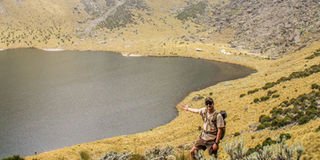Taking the long way up Mount Kenya

Standing high above our camp on Lake Michaelson on Mt Kenya. PHOTO | ANDREAS FOX
What you need to know:
- I have always said I would rather climb Mount Kenya again. Perhaps it’s because there are less people, more varied landscapes and vegetation on our mountain.
- Many climbers start their hike here, trekking up to the Mount Kenya National Park gate. We decided to drive up with a picnic stop en-route. The vegetation changes as you gain altitude, going from thick forest to bamboo, onto Hagenia woodland and, finally, into the moorlands, punctuated with heathers, tussock grass and Protea flowers.
- A howling gale hit us that night, sending whistling winds down from the peaks. The sound of ripping canvas woke a few of us up. For over three hours we were piling rocks on tent seams to keep them from blowing away over a precipice. The toilet tent was destroyed, and our mess tent tried its best to take off.
I was 15 when I first climbed Mount Kenya. I did the Sirimon Route in high school. I remember magnificent vistas, my first snow, a pounding headache and a chesty cough. In hindsight, I shouldn’t have been allowed to make the summit.
In the years since, friends have asked my advice about climbing either Mt Kilimanjaro or Mt Kenya. I’ve never done ‘Kili’ but, strangely, I have always said I would rather climb Mount Kenya again. Perhaps it’s because there are less people, more varied landscapes and vegetation on our mountain.
When I got a call from a guiding colleague about helping out on a trip up the beautiful Chogoria Route, I couldn’t refuse. Knowing that we would take seven days, I was also aware that my altitude sickness might not be a problem.
Our plan was to drive up as far as the road would take us, to the edge of Lake Ellis, 11,000ft up. Turning off the Embu-Meru road just before Chogoria Town, at the sign to the Transit Motel, we hit a recently graded road. The track meanders through villages until it reaches the electric fence erected by the Rhino Ark Foundation – through the Rhino Charge. From here onwards the landscape becomes ever wilder. In the afro-montane rainforest there are monstrous Podo and Wild Magnolia trees. There were regular signs of elephants, buffalos – and leopards too.
Many climbers start their hike here, trekking up to the Mount Kenya National Park gate. We decided to drive up with a picnic stop en-route. The vegetation changes as you gain altitude, going from thick forest to bamboo, onto Hagenia woodland and, finally, into the moorlands, punctuated with heathers, tussock grass and Protea flowers.
Once past the formalities at the gate, the road becomes seriously tough. Ground clearance, four-wheel drive and differential lock, are pretty much obligatory, especially for the steep and loose rocky section up at the top.
GALES AND SNOW
Lake Ellis was a fantastic base camp with opportunity to explore short walking routes, fish for Rainbow trout, and begin our acclimatisation. We spent two nights there, before heading up to Lake Michaelson on day three.
I had heard lots about this place: about the water creating an infinity-pool effect, three waterfalls that disappear underground and plunge hundreds of feet…. all true. It was a good thing we had our fishing permits too; we pulled out a trout each, which were promptly smoked for dinner.
As the summit day got ever closer we rather reluctantly left Michaelson and moved our camp up to 15,000ft, on the edge of Simba Tarn, just below the peaks. Our plan was to wake at 4am the next day, grab a coffee and bowl of porridge, and then head up to Point Lenana, using our headlights to follow our lead guide, Lawrence, a veteran of over 500 climbs. Mount Kenya had other plans.
A howling gale hit us that night, sending whistling winds down from the peaks. The sound of ripping canvas woke a few of us up. For over three hours we were piling rocks on tent seams to keep them from blowing away over a precipice. The toilet tent was destroyed, and our mess tent tried its best to take off.
Eventually, the skies cleared – but only after a short snowfall. Exhausted, but buoyed by the starry conditions, we went for it. It wasn’t the clearest of dawns, but we could see all the way back along our route, the sun glistening off Harris Tarn and Lakes Ellis and Michaelson.
All our heads were fine too – the payoff for really taking our time. It was then back down for breakfast before the long march back to Ellis. We were shattered, but the sense of achievement and appreciation for the mountain’s beauty was palpable. What made it even better was that the group had done the climb as a fundraiser for the March To The Top foundation.
The phenomenal amount of money raised has directly impacted projects such as the New Hope Orphanage in Meru, the Amboseli Trust for Elephants, and Dandora Maternity Clinic.
Mount Kenya will always be high up on my list of recommendations, particularly the Chogoria route. My only gripe is with the people who are able to carry full bottles of water and packaged food up but seem unwilling to take down their rubbish. The mountain really is special; let’s keep it that way.
We did it in huge comfort with specialist operator, Sean Dundas’ Equatorial Mountains. However, those on a tighter budget can pick up guides and porters in almost every town around the mountain and camp in the vicinity of the KWS huts. The Transit Motel is a good bet for Chogoria, and there are even operators with old Land Rovers ready to take you up that amazing road if you don’t feel like hiking.





